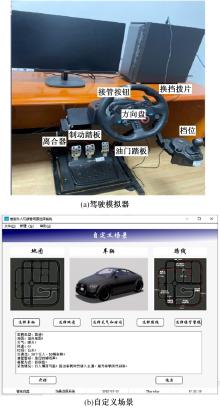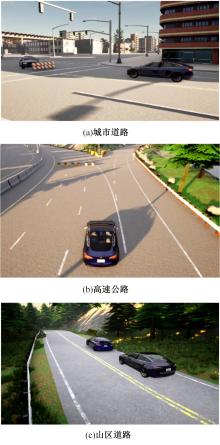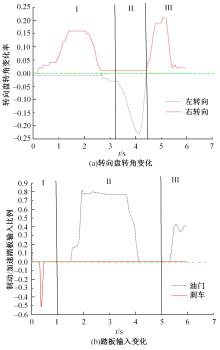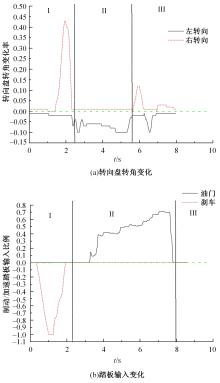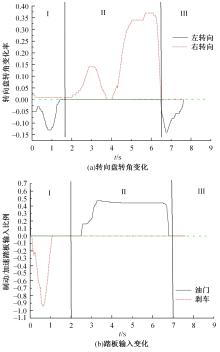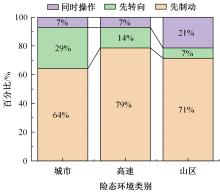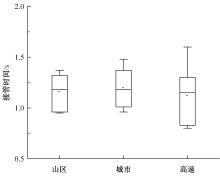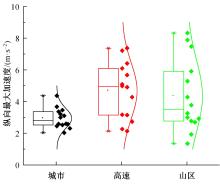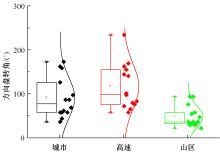Journal of Jilin University(Engineering and Technology Edition) ›› 2024, Vol. 54 ›› Issue (3): 683-691.doi: 10.13229/j.cnki.jdxbgxb.20220580
Analysis of characteristics of the takeover behavior of co⁃driving intelligent vehicles under different dangerous scenarios
Li-xin YAN( ),Jin-pei FENG,Jun-hua GUO,Yi-ke GONG
),Jin-pei FENG,Jun-hua GUO,Yi-ke GONG
- School of Transportation Engineering,East China Jiaotong University,Nanchang 330013,China
CLC Number:
- U491.25
| 1 | 胡云峰, 曲婷, 刘俊,等. 智能汽车人机协同控制的研究现状与展望[J]. 自动化学报, 2019, 45(7): 1261-1280. |
| Hu Yun-feng, Qu Ting, Liu Jun, et al. Human-machine cooperative control of intelligent vehicle: recent developments and future perspectives[J]. Automatic Chemical, 2019, 45(7): 1261-1280. | |
| 2 | SAE J3016. Taxonomy and definitions for terms related to on-road motor vehicle automated driving systems [S]. |
| 3 | 姚荣涵, 徐文韬, 郭伟伟. 基于因子长短期记忆的驾驶人接管行为及意图识别[J]. 吉林大学学报: 工学版, 2023, 53(3): 758-771. |
| Yao Rong-han, Xu Wen-tao, Guo Wei-wei, et al. Drivers' takeover behavior and intention recognition based on factor and long short⁃term memory[J]. Journal of Jilin University (Engineering and Technology Edition), 2023, 53(3): 758-771. | |
| 4 | Dogan E, Honnêt V, Masfrand S, et al. Effects of non-driving-related tasks on takeover performance in different takeover situations in conditionally automated driving[J]. Transportation Research Part F: Traffic Psychology and Behaviour, 2019, 62: 494-504. |
| 5 | Zeeb K, Buchner A. Is take-over time all that matters? The impact of visual-cognitive load on driver takeover quality after conditionally automated driving[J]. Accident Analysis & Prevention, 2016, 92: 230-239. |
| 6 | 鲁光泉, 赵鹏云, 王兆杰, 等. 自动驾驶中视觉次任务对年轻驾驶人接管时间的影响[J]. 中国公路学报, 2018, 31(4): 165-171. |
| Lu Guang-quan, Zhao Peng-yun, Wang Zhao-jie, et al. Effects of visual tasks on young drivers in automatic driving[J]. Journal of China Road, 2018, 31(4): 165-171. | |
| 7 | Park S, Jeong H, Kwon C, et al. Analysis of take-over time and stabilization of autonomous vehicle using a driving simulator[J]. The Journal of The Korea Institute of Intelligent Transport Systems, 2019, 18(4): 31-43. |
| 8 | Park S, Yun Y W, Ko H,et al. Analysis of the influence of road traffic conditions and weather on the take-over of a conditional autonomous vehicle[J]. The Journal of the Korea Institute of Intelligent Transport Systems, 2020, 19(6): 235-249. |
| 9 | Kim J W, Yang J H. Understanding metrics of vehicle control take-over requests in simulated automated vehicles[J]. International Journal of Automotive Technology, 2020, 21(3): 757-770. |
| 10 | Lin Q F, Lyu Y, Zhang K F, et al. Effects of non-driving related tasks on readiness to take over control in conditionally automated driving[J]. Traffic Injury Prevention, 2021, 22(8): 629-633. |
| 11 | Samani A R, Mishra S, Dey K. Assessing the effect of long-automated driving operation, repeated take-over requests, and driver's characteristics on commercial motor vehicle drivers' driving behavior and reaction time in highly automated vehicles[J]. Transportation Research Part F: Traffic Psychology and Behaviour, 2022, 84: 239-261. |
| 12 | Feldhütter A, Gold C, Schneider S, et al. How the duration of automated driving influences take-over performance and gaze behavior[C]∥Advances in Ergonomic Design of Systems, Products and Processes, Springer, Berlin, Heidelberg, 2017: 309-318. |
| 13 | Radlmayr J, Gold C, Lorenz L, et al. How traffic situations and non-driving related tasks affect the take-over quality in highly automated driving[J]. Proceedings of the Human Factors & Ergonomics Society Annual Meeting, 2014, 58(1): 2063-2067. |
| 14 | 钮建伟, 张雪梅, 孙一品, 等. 险情中驾驶人接管自动驾驶车辆的驾驶行为研究[J]. 中国公路学报, 2018, 31(6): 272-280. |
| Niu Jian-wei, Zhang Xue-mei, Sun Yi-pin, et al. Study on the driving behavior of the driver in the automatic driving vehicle in the danger[J]. Journal of China Road, 2018, 31(6): 272-280. | |
| 15 | 林庆峰, 王兆杰, 鲁光泉. 城市道路环境下自动驾驶车辆接管绩效分析[J]. 中国公路学报, 2019, 32(6): 240-247. |
| Lin Qing-feng, Wang Zhao-jie, Lu Guang-quan. Analysis of automatic driving vehicle in urban road environment[J]. Journal of China Highway, 2019, 32(6): 240-247. | |
| 16 | Körber M, Gold C, Lechner D, et al. The influence of age on the take-over of vehicle control in highly automated driving[J]. Transportation Research Part F Traffic Psychology & Behaviour, 2016, 39: 19-32. |
| 17 | Wu C, Wu H, Lyu N, et al. Take-over performance and safety analysis under different scenarios and secondary tasks in conditionally automated driving[J]. IEEE Access, 2019, 7: 136924-136933. |
| 18 | 郭烈, 胥林立, 秦增科, 等. 自动驾驶接管影响因素分析与研究进展[J]. 交通运输系统工程与信息, 2022, 22(2): 72-90. |
| Guo Lie, Xu Lin-li, Qin Zeng-ke, et al. Analysis and research progress of influencing factors of autonomous driving takeover[J]. Transportation Systems Engineering and Information Technology, 2022, 22(2): 72-90. | |
| 19 | Ito T, Takata A, Oosawa K. Time required for take-over from automated to manual driving[C]∥SAE International Paper, 2016-01-0158. |
| 20 | Clark H, Feng J. Age differences in the takeover of vehicle control and engagement in non-driving-related activities in simulated driving with conditional automation[J]. Accident Analysis & Prevention, 2017, 106: 468-479. |
| [1] | Xian-yi XIE,Yu-han WANG,Li-sheng JIN,Xin ZHAO,Bai-cang GUO,Ya-ping LIAO,Bin ZHOU,Ke-qiang LI. Intelligent vehicle trajectory tracking control based on adjusting step size of control horizon [J]. Journal of Jilin University(Engineering and Technology Edition), 2024, 54(3): 620-630. |
| [2] | Zhen-hai GAO,Rong-gui CAI,Tian-jun SUN,Tong YU,Hao-yuan ZHAO,Hao BAN. Data⁃filtering method for driving behavior based on vehicle shared autonomy [J]. Journal of Jilin University(Engineering and Technology Edition), 2024, 54(3): 589-599. |
| [3] | Rong-han YAO,Wen-tao XU,Wei-wei GUO. Drivers' takeover behavior and intention recognition based on factor and long short⁃term memory [J]. Journal of Jilin University(Engineering and Technology Edition), 2023, 53(3): 758-771. |
| [4] | Wei ZHANG,Shu-pei ZHANG,Chong-en LUO,Sheng ZHANG,Guo-lin WANG. Collision avoidance trajectory planning for intelligent vehicles in emergency conditions [J]. Journal of Jilin University(Engineering and Technology Edition), 2022, 52(7): 1515-1523. |
| [5] | ZHANG Lin, ZHANG Xin-jie, GUO Kong-hui, WANG Chao, LIU Yang, LIU Tao. Rolling window optimization for intelligent vehicle trajectory planning in unknown environment [J]. 吉林大学学报(工学版), 2018, 48(3): 652-660. |
| [6] |
LI Ai-juan,LI Shun-ming,ZHAO Wan-zhong,SHEN Huan,JIANG Xing-xing, QIU Xu-yun,WANG Hui-jun. Optimal control theory based trajectory generation method for intelligent vehicle [J]. 吉林大学学报(工学版), 2014, 44(5): 1276-1282. |
| [7] | LI Ai-juan, LI Shun-ming, SHEN Huan, MIAO Xiao-dong. ACT-R based dynamic trajectory optimization method for intelligent vehicles [J]. 吉林大学学报(工学版), 2013, 43(05): 1184-1189. |
| [8] | GUO Lie, HUANG Xiao-hui, GE Ping-shu, ZHANG Guang-xi, YUE Ming. Lane changing trajectory tracking control for intelligent vehicle on curved road based on backstepping [J]. 吉林大学学报(工学版), 2013, 43(02): 323-328. |
| [9] | Wang Rong-ben, Zhang Rong-hui, You Feng, Chu Jiang-wei, Jin Li-sheng . Curve trace tracking control algorithm of intelligent vehicle [J]. 吉林大学学报(工学版), 2006, 36(05): 731-0735. |
| [10] | MA Lei, WANG Rongben. Intelligent vehicle steering control [J]. 吉林大学学报(工学版), 2004, (4): 582-586. |
|
||
